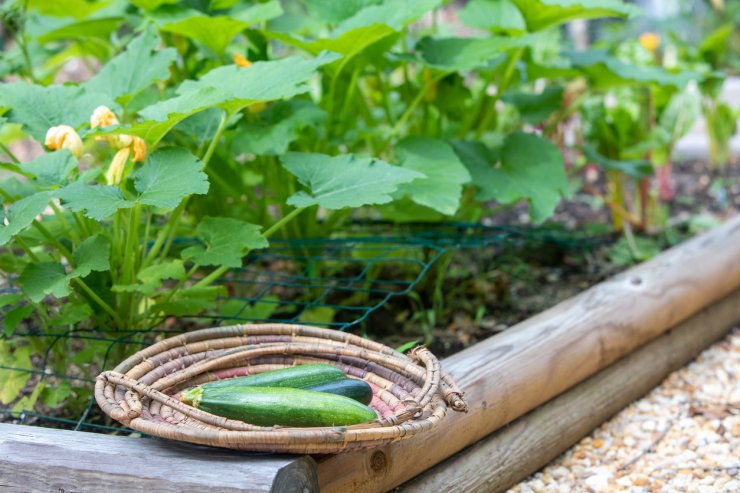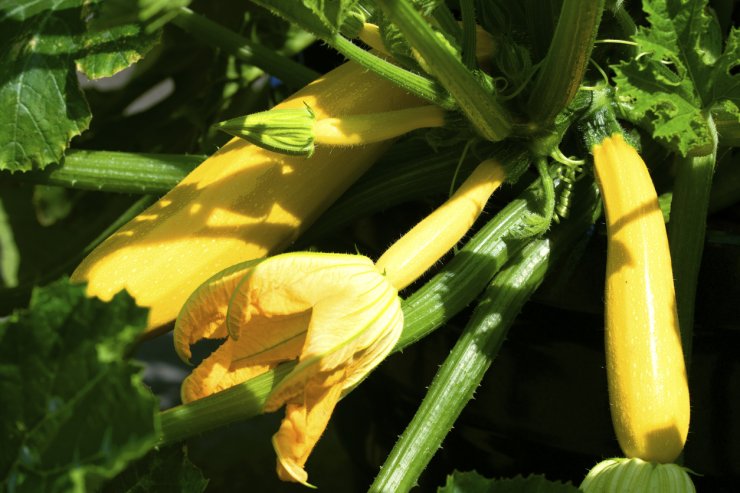
Summer squash growing in summer garden.
Squash is a warm-season crop, very susceptible to frost and light freezes. Summer squash can be grown almost anywhere, as the vines develop quickly. Harvest begins in two months.
Sow squash directly outside at least a week after your last frost date, or when the soil temperature has warmed to at least 60 degrees F at a 2-inch depth to ensure your seeds don’t rot before they sprout. You want the air temperatures to be settled to avoid last spring frosts.
- Tip: In non-tropical parts of the country, the soil will be about 60 degrees F when roses are in bud and lilacs are in bloom.
The same goes for transplants: Don’t set them out until the weather has warmed to 70 degrees F. Check with your local extension service for up-to-date information in your neighborhood.
- Tip: If you’re growing your own seedlings indoors, use peat pots with the bottoms removed to make it less likely that you’ll disturb the taproot when transplanting.
Don’t rush! Waiting to plant will avoid problems from pests and diseases that are common earlier in the spring season.
Where to Plant

Row of squash plants.
In general, squash plants like lots of room to spread out. For summer squash that is mostly bush varieties, space your rows 4 to 6 feet apart, with plants 15 to 20 inches apart.
Pick a spot with full sun, shelter from wind for good pollination, and well-draining soil. Squash like a slightly acidic soil: between 6.0 to 6.8 pH is best. If your soil is too acidic, add lime according to the instructions on your product.
But don’t worry needlessly. Squash can tolerate a soil pH as low as 5.5, so don’t worry about liming unless your soil is strongly acidic. Always perform a soil test (your county extension service or local nursery can help you with this) before adding anything that will affect your soil’s pH.
Squash are heavy feeders and benefit from soil rich in organic matter. Add seasoned manure or mature compost to your soil. For best results, work in one cup of complete organic fertilizer beneath transplants. If planting from seed, work the fertilizer into the top 2 to 3 inches of soil.
A word about sunlight

Summer squash growing in the sun.
Squash plants need full sun to produce. Make sure you’re planting your seeds or starts in an area with at least six hours of sunlight per day. More is better, but if the weather gets too hot for too long, your squash plants may droop with stress. If this happens, it’s a sign your plant is trying to conserve its resources. Most will perk up again when the heat subsides in the evening, but if they don’t, consider adding a shade cloth or other temporary heat protection.
Where have you planted your summer squash? What criteria for site selection has worked for you? Please share your ideas with us.


 Previous
Previous


what to do if plant gets white mold spots . I cut some leaves off and moved into more sun per day.. Please advise….
Linda,
It sounds like you may have some powdery mildew. This disease thrives in warm, dry conditions and amazingly can survive in the soil over the winter. Once you see infected leaves, cut them off and dispose them, but not in your compost bin. You can also try spraying the leaves with neem oil. Next season you can try crop rotation and also make sure that you are giving your squash plants plenty of room for increased airflow.
Good luck and happy gardening!